

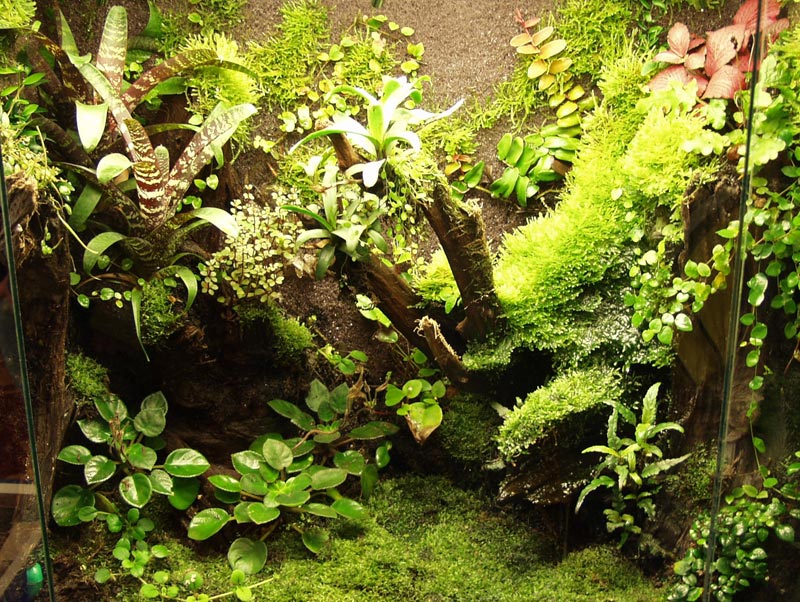
Technically speaking, a paludarium does not need to include any plants at all, but the attractive display created by a richly planted tank has a huge impact on us all. People are simply drawn to such beauty. But what paludarium plants to chose?
The answer to this question will be formed by three main factors: firstly what are you trying to achieve? Perhaps an accurate biotope tank; maintaining a mix of species (both plants and animals) that occur together in nature, in as natural conditions as possible. Maybe you just want a truly impressive planted display. Or still, a more functional enclosure where plants are solely for the benefit of animal species.
Secondly, you will be limited to plants that will survive in the tank provided. Paludarium plants must be able to withstand the humidity, temperature and light levels in which they will be housed. They must also be able to tolerate other paludarium occupants, their food, and not cause harm themselves. No larger carnivorous plants, bromeliads with sharp leaf edges, or plants with known toxicity.
The final limitation is the availability of species. There are probably thousands of plant species suitable for your paludarium, though few will be regularly available. There are some 13000 species of fern in nature; how many are in stores? Some of the easiest to grow house plants and aquarium species will be available in a local nursery, pet store or garden center. Certainly Creeping Fig Ficus pumila, Devil's Ivy Epipremnum aureum etc, and aquatic species like Anubias and Cryptocoryne. Many more species will be available from specialist plant breeders online.
Of course, a Paludarium can contain solely aquatic, or semi aquatic-plants, or exclusively terrestrial plants. It may also have epiphytic plants (i.e. those that grow on the surface of another plant - usually a tree) - this will depend on the precise nature of your set-up. An all-aquatic plant tank might not be very tall, but have a large waterfall coated with java moss; with Cryptocoryne or Anubias growing emersed from the water. In contrast, a dark jungle stream with little light penetration would typically have no aquatic plants; primarily epiphytic plants and vines on the land portion, and just deep piles of leaf litter within the water: the perfect Amazon rainforest tank featuring small dart frogs and Rivulus killifish! Of course tank inhabitants do not notice what plant species are living around them, and can be quite happy with purely artificial plants.
Obviously a paludarium has water as a significant feature, whilst a vivarium does not. Both could represent a similar environment (for example Amazon rainforest) and house similar animal species, but the increased moisture of the paludarium does affect the plant choices available. Vivaria will typically receive regular mistings, but still not be moist enough to let certain species thrive. By contrast paludaria, despite good ventilation, will typically have wetter, even waterlogged areas of land, and areas of significantly higher humidity, probably close to 100% humidity in areas. The plants suggested below are all species that can tolerate higher levels of humidity, yet even these (particularly the orchids and bromeliads) might not thrive in every paludarium. A large enough tank can have wetter and dryer zones, and some plants will need to be kept strictly in one or the other. You may need to experiment with ventilation and planting positions before permanent planting positions for some species can be established.
Another option that works well is the concept of temporary planting. Individual orchids and bromeliads are kept potted or grown epiphytically on removeable substrates - these can be given periodic breaks from any installation, kept in rotation with other specimens. A few months break in a greenhouse, or even as a houseplant, can, to some extent, replicate the dryer seasons the plant would experience in nature, but also allow close inspection, removal of dead leaves etc. Be careful, especially when rotating bromeliads, that frogs are not resting between the leaves of these plants when removed.
Although you can order plants online, it's always good to look in a garden center when you are passing. Look for small tropical plants, typically in 1 to 3 inch pots. Plants with darker leaf colors usually require less light and will do better in the long run. They can be coastal plants, bog plants, and tropical forest plants. Below are some examples of plants that are worth considering in a paludarium.
As mentioned above, there are many thousands of plant species. Some favourites are described here, but there are no doubt huge numbers of suitable species that could work in any tropical set-up. Got any great suggestions, not mentioned here? comment
Fittonia verschaffeltii this Peruvian plant has the most attractive leaf patterns, and is widely available in a variety of different colours. It likes to be wet; and can be planted in the lower regions of the tank.
Strawberry Begonia Saxifraga stolonifera Despite the name, not a Begonia, nor a strawberry. This rather attractive Chinese plant has scalloped leaves with pale whiteish veins and pink stems. A good moisture loving species, but one that needs a cooler tank (under 25°C). Propagates via numerous runners. buy.
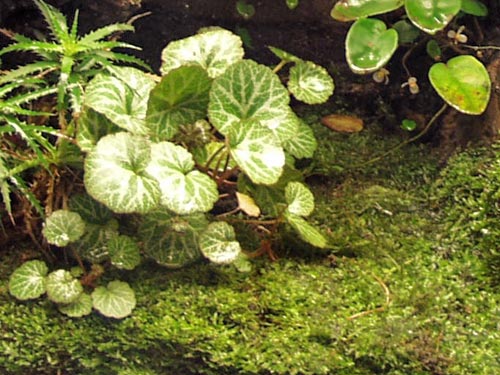 The Strawberry Begonia growing in a terrarium
The Strawberry Begonia growing in a terrarium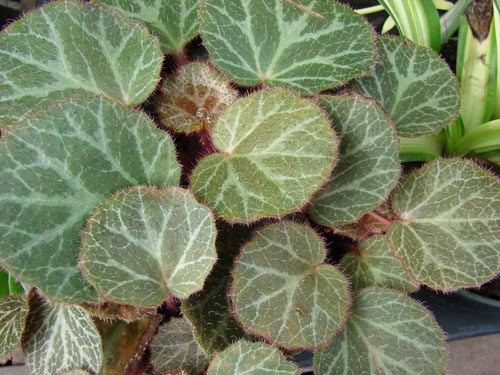 Strawberry Begonia. Photo Forest and Kim Starr.
Strawberry Begonia. Photo Forest and Kim Starr.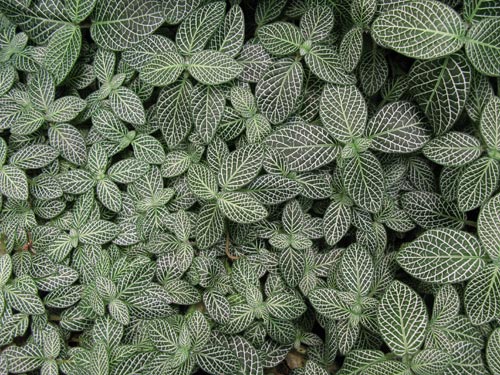 Fittonia verschaffeltii. Photo TANAKA Juuyoh.
Fittonia verschaffeltii. Photo TANAKA Juuyoh.There are numerous creepers that can quickly cover the back wall of a paludarium, easily attaching to cork or coco fibre backing, filling in space between feature plants. Perfect for a typical rainforest-style installation. Creeping Fig, Pothos, Scindapsus and Philodendron are all incredibly easy plants to grow, widely available in local stores and inexpensive to buy. These plants are all ideal species for a newly installed paludarium, but will require considerable pruning (especially Pothos and Scindapsus). Once a tank is established some of these plants may even be viewed as too invasive.
Creeping Fig Ficus pumila a small leafed creeping vine that will quickly expand to cover back walls, and surface areas within a tank. This is a very hardy plant that tolerates a wide range of conditions, adapting well to dry and more humid zones of the tank. This plant will quickly create dense areas of vegetation, and even strangle other species. Will typically require regular pruning. buy
Pothos Epipremnum aureum is an incredibly versatile plant, with medium sized waxy variegated leaves, easily sturdy enough to support the weight of a small frog. There are some non-variegated pure green forms, and even a hybrid 'Marble Queen' that has strong white variegations. When kept in dimmer conditions, variegation tends to diminish. Pothos is at home in all regions of the tank, and will rapidly overtake other plants if not kept in check. buy. Epipremnum pinnatum is a very similar looking species when leaves are small, though they tend to be darker green without variegations. Older, larger, leaves eventually become pinnate, hence the species name - that is to say they develop side-slits, like a cheese plant (Monstera Deliciosa), though this is unlikely in the confines of all but the largest installations. buy
Devil's Ivy Scindapsus aureus is very similar plant to Pothos, and the two species are regularly lumped together. Scindapsus pictus has similar shaped leaves but with very attractive silver blotches. A great feature of these plants is that, although typically sold as a rooted plant, they can survive without planting, as long as their roots have access to moisture. Many aquarists use this plant to remove nitrates and other nutrients from tank water - the leaves trailing down outside the tank, the long roots, reaching down into the water, sucking nutrients and providing a refuge for smaller fish. Enjoys any level of moisture. buy
Heartleaf Philodendron Philodendron scandens although similar in looks to Pothos and Scindapsus, P. scandens has deeper green heart-shaped leaves. It is slower growing, and less likely to overtake the tank, but still hardy enough to be regarded as an excellent first paludarium species. buy
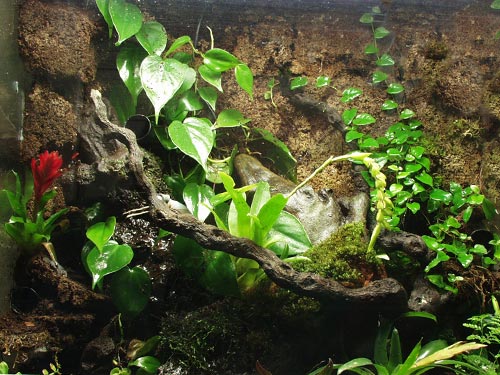 Philodendron scandens (left) and Ficus pumila (right) enjoying the moisture of a typical paludarium
Philodendron scandens (left) and Ficus pumila (right) enjoying the moisture of a typical paludarium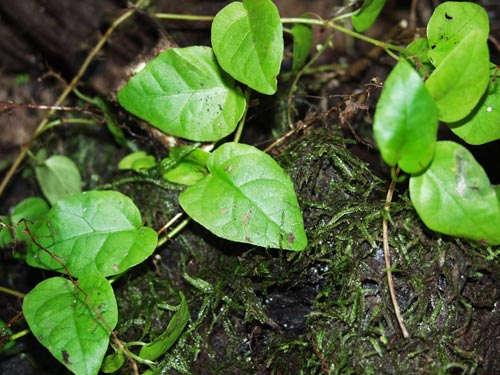 A close up look at Ficus pumila; in the vivarium, leaves are small, typically around 2cm in length
A close up look at Ficus pumila; in the vivarium, leaves are small, typically around 2cm in length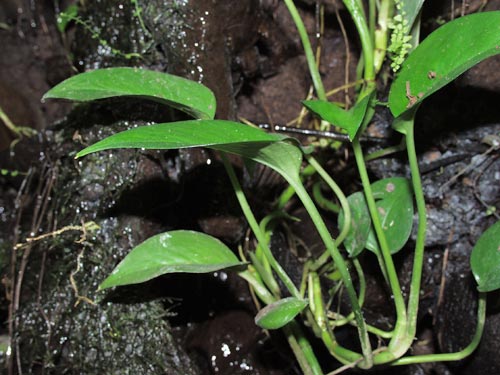 Scindapsus is a great plant for a moist paludarium. It is quick growing, and creates wonderful walkways for small frogs
Scindapsus is a great plant for a moist paludarium. It is quick growing, and creates wonderful walkways for small frogs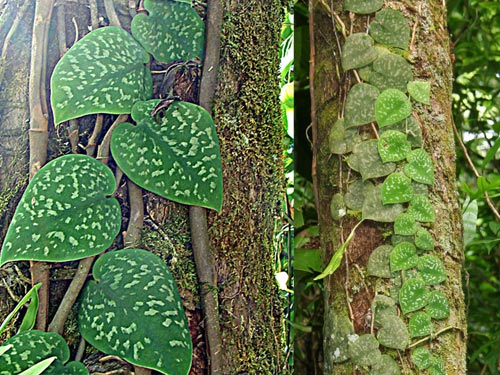 Scindapsus pictus in the wild. A terrific creeping plant, with beautiful leaves. Photos Dick Culbert and Andrey Zharkikh
Scindapsus pictus in the wild. A terrific creeping plant, with beautiful leaves. Photos Dick Culbert and Andrey Zharkikh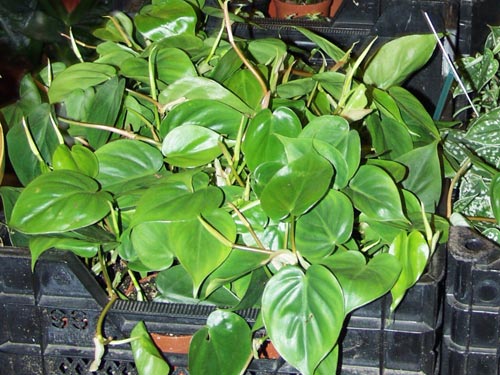 Philodendron plants awaiting sale
Philodendron plants awaiting sale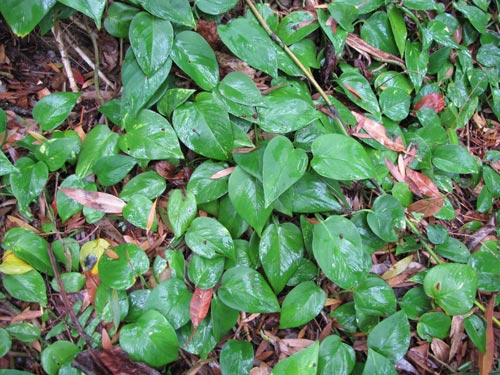 Epipremnum pinnatum growing wild in Maui, Hawaii. Photo Forest and Kim Starr
Epipremnum pinnatum growing wild in Maui, Hawaii. Photo Forest and Kim StarrAs mentioned above there are over 13000 species of plants in the fern family, plus many more crossbreeds and cultivars. Ferns are great space filling plants between tank structures. Most grow rapidly - often too rapidly, and many grow too large. Look for smaller species. Great when getting a tank set up initially, but be prepared to replace too vigorous plants. Other members of the genus Nephrolepis occasionally become available, and may be worth trying. Many species thrive in the moisture of the paludarium, their substrate should remain moist, but not soggy. One great feature of quicker growing species is that they will grow where they want - doing less well in zones of the tank that are less suitable, and moving into zones that they prefer.
Nephrolepis exaltata the Boston fern is an easy paludarium species, enjoying high moisture levels, and low to moderate light levels. It is widely available in any houseplant store, and the small plants offered look just perfect for the vivarium. It is, however, too big for a typical set-up. It can be used very effectively in larger enclosures, if regularly trimmed. buy
Nephrolepis cordifolia 'Duffii' Lemon Button fern, Fluffy Duffy. Another smaller cultivar of Nephrolepis genus, very well suited to the vivarium or paludarium. Fronds tend not to exceed 10-12 inches in length. buy
Nephrolepis exaltata 'Marisa' this cultivar of the Boston fern is much smaller, with quite different soft-textured 'fluffy' foliage. Best grown epiphytically, attached to cork panelling. buy
Arachniodes aristata known as the Holly fern due to the shape of it's leaves. This small Indian fern enjoys moist conditions and is therefore a good candidate for paludaria. It is one of the slower growing fern species typically used. Available in variegated and non-variegated forms. buy
Polystichum tsus-simense Enjoys low light levels and moist (but not waterlogged) soil. A great species for the paludarium, though may require regular pruning to prevent it becoming too large. buy
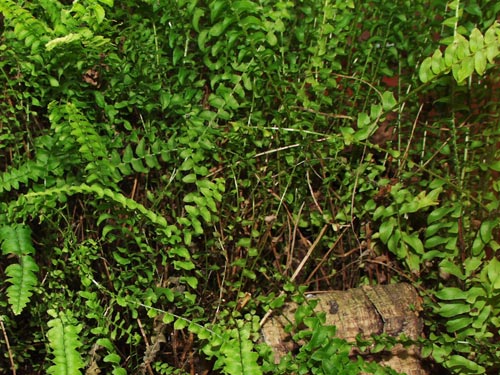 Boston Ferns, Nephrolepis exaltata are way too big for the typical paludarium, but can be used if larger fronds are regularly removed
Boston Ferns, Nephrolepis exaltata are way too big for the typical paludarium, but can be used if larger fronds are regularly removed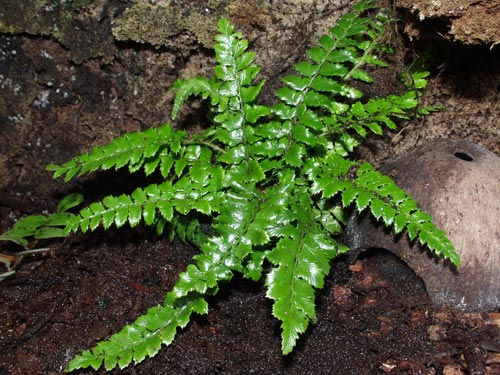 Arachniodes aristata is a slow growing fern from India and Sri Lanka. The non-variegated form is shown here
Arachniodes aristata is a slow growing fern from India and Sri Lanka. The non-variegated form is shown here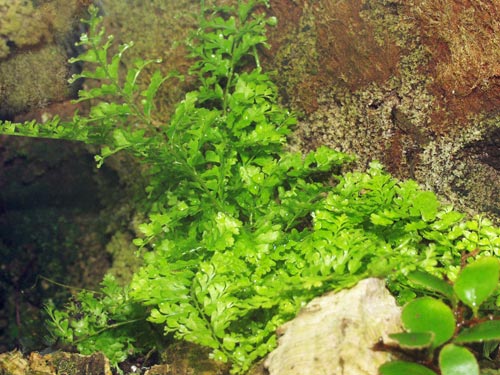 Nephrolepis exaltata 'Marisa' is much smaller than other ferns, and although sometimes difficult to procure, is an excellent paludarium species
Nephrolepis exaltata 'Marisa' is much smaller than other ferns, and although sometimes difficult to procure, is an excellent paludarium species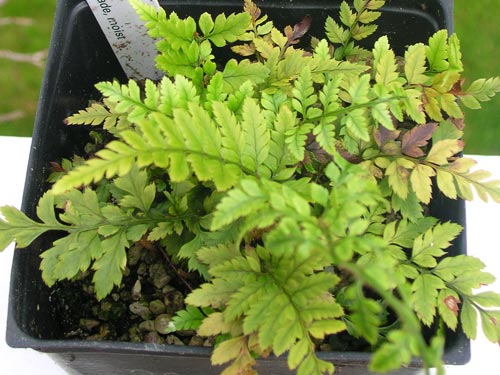 Polystichum tsus-simense. Photo brew books
Polystichum tsus-simense. Photo brew booksBromeliads, and their relationship with dart frogs are well known. Many dart frog keepers will regard these as some of the most important plants to keep in their paludarium. Read more about Bromeliad care here.
Neoregelia 'Pheasant' a beautiful small-sized bromeliad perfect for smaller installations. Other mini varieties are becoming increasingly available. buy
Tillandsia stricta Tillandsia bromeliads are also known as air plants. T. stricta is widely available and generally inexpensive. Can be siliconed in place. Better for higher (dryer) zones of the paludarium buy
Cryptanthus microglaziouii (Cryptanthus Bromeliad, Earth Star). This terrestrial species, endemic to Brazil is an outstanding plant for the paludarium: it doesn't get too large, is very attractive, and enjoys being wet. This species should not be allowed to dry out, and can be planted in the lower (wetter) zones in any tank. It does have serrated edges, so best not used when housing softer animals like frogs. buy
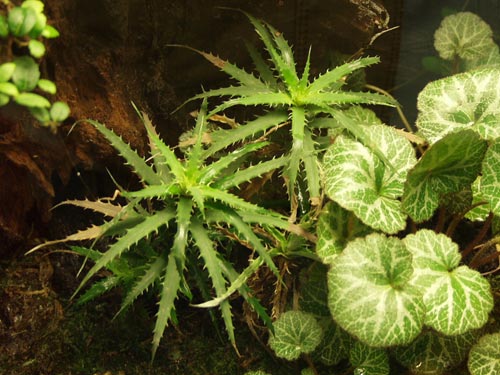 Cryptanthus microglaziouii planted in a vivarium
Cryptanthus microglaziouii planted in a vivarium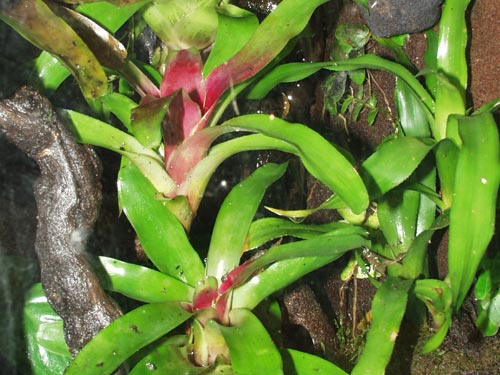 Neoregelia bromeliads planted in a vivarium
Neoregelia bromeliads planted in a vivarium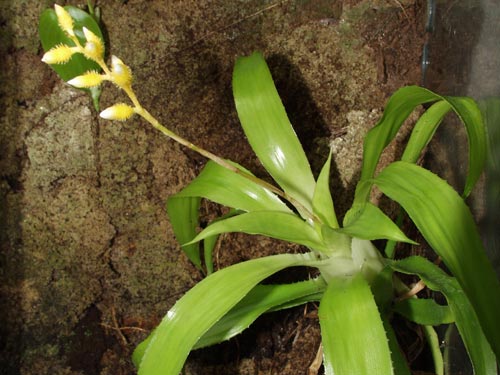 Vriesea with flower spike
Vriesea with flower spike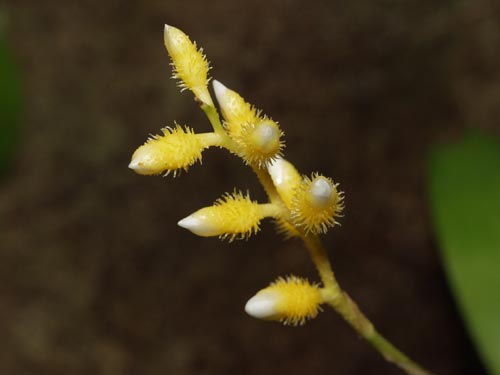 Close-up of Vriesea flower
Close-up of Vriesea flower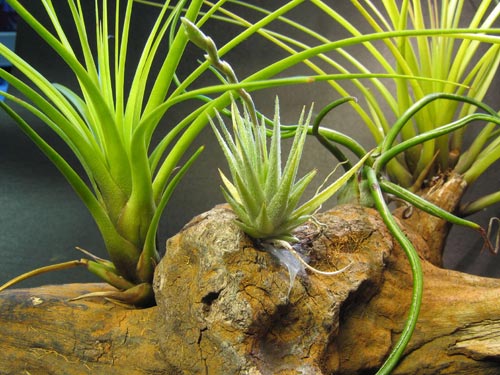 Tillandsia loliacea with flower spike. Photo James Ho
Tillandsia loliacea with flower spike. Photo James Ho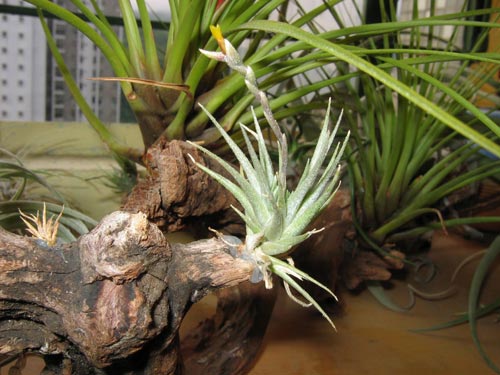 Tillandsia loliacea with flower spike. Photo James Ho
Tillandsia loliacea with flower spike. Photo James Ho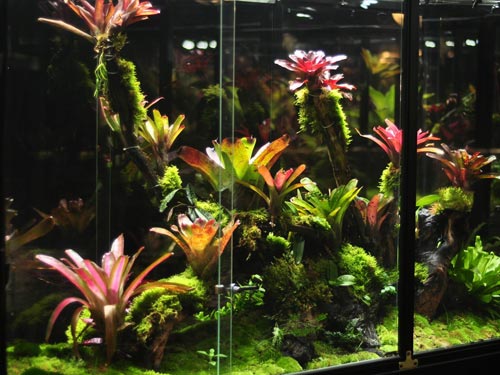 A wonderful bromeliad terrarium with many small species growing attached to wood. Photo Dũng Nguyễn Việt
A wonderful bromeliad terrarium with many small species growing attached to wood. Photo Dũng Nguyễn Việt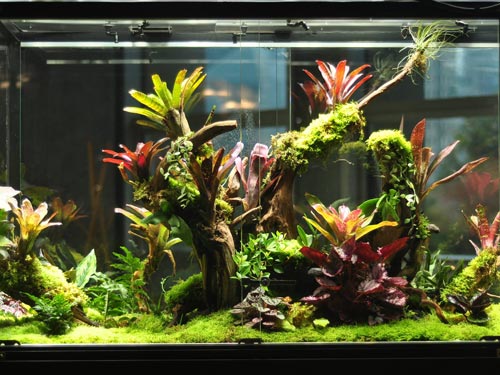 Another superb bromeliad tank. Photo Dũng Nguyễn Việt
Another superb bromeliad tank. Photo Dũng Nguyễn ViệtMosses are something that just make a tank look great. They take time to become established, but give the feel of a superbly lush, moist environment. There are over 12000 different species, but for the paludaria, typically one species is head and shoulders above all the rest in terms of usefulness and availability. That is Java Moss. Actually, in a well developed tank, with sufficient moisture, some mosses will appear without introduction from the keeper - especially in brighter areas of the tank. Moss spores can be introduced on plants, animals, tank decor (wood, stones) - and they are in the air all around us.
There are also numerous mosses suitable for the vivarium available online. Many are unnamed species, simply given generic names: frog moss, tropical moss, vivarium moss etc. Some may do better than others in different set-ups. It will probably be worth experimenting.
Mosses, obviously grow all over the world, and it can be tempting to find a rich slab of moss from your garden, roof, or local woodland, and place that in a tank. Whether this would survive would depend the difference in your local climate compared to your paludarium. This approach can work, even if the moss is replaced periodically, and is a great shortcut to a wonderfully green floor. However, it should be used with caution. It can introduce unwanted animal pests, pathogens, and even unwanted plant and fungus species. Having mushrooms grow out of harvested moss slabs is not at all unusual, and slugs and snails can rabidly devour certain plants.
Java moss . Although better known as an aquatic plant, Java Moss will grow emersed as long as it is continually moist. Often it just sits in a clump in the aquarium, but will readily attach to wood, rock, gravel etc. It is very hardy, and enjoys any lighting conditions. In low light conditions (typically in the water section of the paludarium) it will have deep green fronds, but grow slowly. In brighter light (higher up the walls) it can grow very quickly and has a nice light green colour. buy
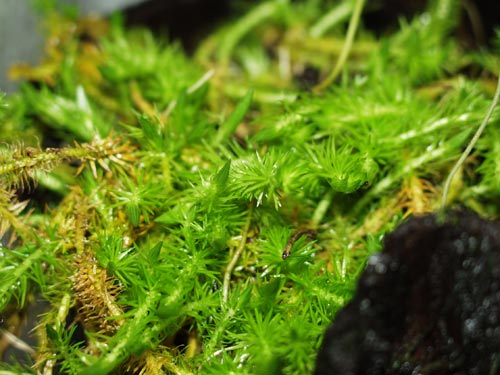 Sphagnum moss can work very well in some paludaria
Sphagnum moss can work very well in some paludaria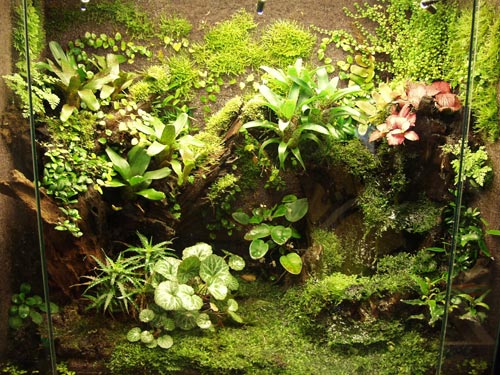 A lushly planted tank with large amounts of Java moss: deep green moss on the floor, bright green moss high on the back wall
A lushly planted tank with large amounts of Java moss: deep green moss on the floor, bright green moss high on the back wall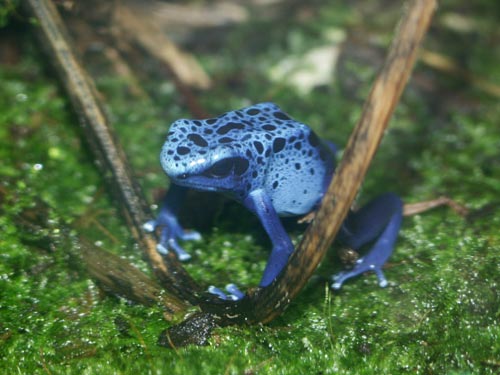 Frogs (in this case Dendrobates tinctorius "azureus") love sitting on nice moist patches of moss
Frogs (in this case Dendrobates tinctorius "azureus") love sitting on nice moist patches of moss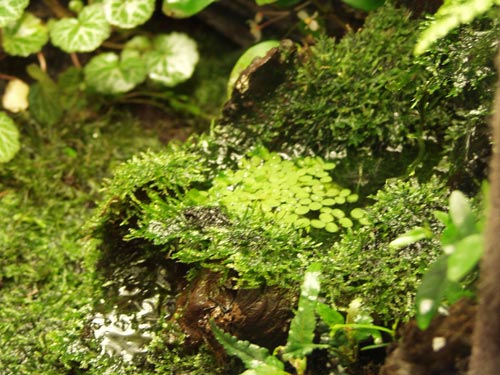 Java moss attaches easily to wood, forming wonderful soft cushions anywhere it can
Java moss attaches easily to wood, forming wonderful soft cushions anywhere it canThere are over 22000 species of orchid, with more being discovered every month. Like so many of the plants discussed on this page, there are numerous species that would be suitable for paludarium life, but generally the smaller ones are the best fit. Like bromeliads, these plants can tolerate considerable humidity, but too much wetness will kill them. They do well in the paludarium, but must be situated away from the splashes of waterfalls etc. They certainly do best grown epiphytically on tree fern bark in the upper levels of the tank, and may also benefit from a periodic breaks in a cooler dryer environment, simulating the dryer winter conditions. Orchids, in general, are not quite as easy plants to keep as some of the other types listed on this page, but, especially due to their attractive flowers, and interesting foliage, are well worth attempting.
Phalaenopsis fasciata Phalaenopsis are perhaps the best known orchid houseplants, but the varieties seen in non specialist stores will typically be too large. P. fasciata is smaller (leaf size around 20cm) but by no means miniature. Named after it's lovely striped flowers. It is well suited to the paludarium, as long as it has good ventilation. buy
Dendrobium kingianum Of the many Dendrobium species, this is one of the easier to maintain, and although a little large for some set-ups, it will tolerate typical vivarium / paludarium conditions. In nature, this Australian species is usually lithophytic (roots in cracks in rocks), but will also do well as an epiphyte. buy
Dendrobium atroviolaceum A beautiful miniature Dendrobium species from Papua New Guinea. A good candidate for the vivarium, but must have adequate ventilation. buy
Braided orchid Lockhartia oerstedii hails from South and Central America, and is a perfect small epiphytic orchid for the vivarium or paludarium. It comes from mountain forests, so may prefer a slightly cooler position. This orchid flowers quite easily. buy
Ornithophora radicans (also found under the older name Sigmatostalix radicans) A nice small epiphytic species that tolerates lower and intermediate temperatures, low light levels and moderate humidity. Comes from the Atlantic forests of southern Brazil. A good candidate for a rainforest paludarium. buy
Physosiphon tubatus A small mountain forest epiphyte from Central America. Great miniature species for cooler terrariums and paludariums.
Ludisia discolor Jewel orchid. South east Asian terrestrial orchid that grows on the forest floor (not an epiphyte!). Must be kept moist but never soggy - 70% humidity is good. Happy in low light so generally a good species for rainforest paludariums. Has very attractive pinstriped leaves. buy
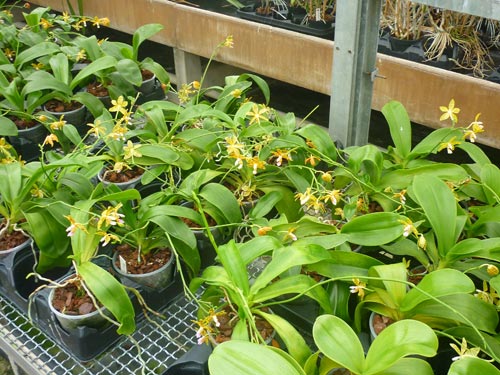 Phalaenopsis fasciata. Photo Felix
Phalaenopsis fasciata. Photo Felix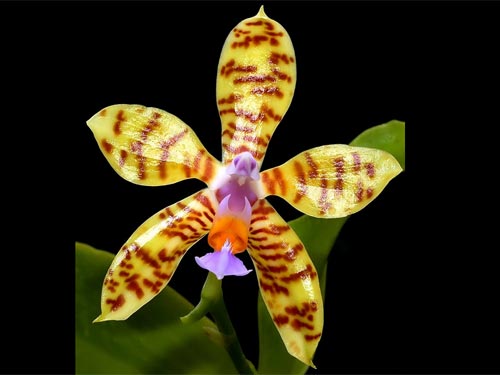 Phalaenopsis fasciata flower. Photo wikimedia.
Phalaenopsis fasciata flower. Photo wikimedia.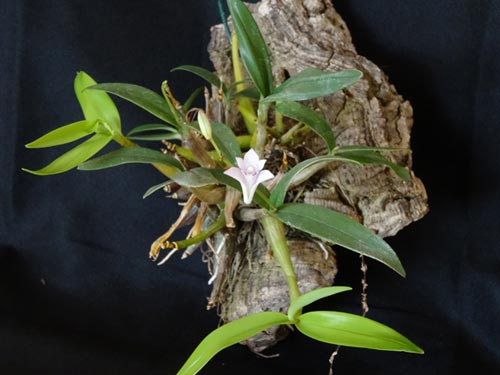 Dendrobium kingianum is one of the easier Dendrobiums for the paludarium
Dendrobium kingianum is one of the easier Dendrobiums for the paludarium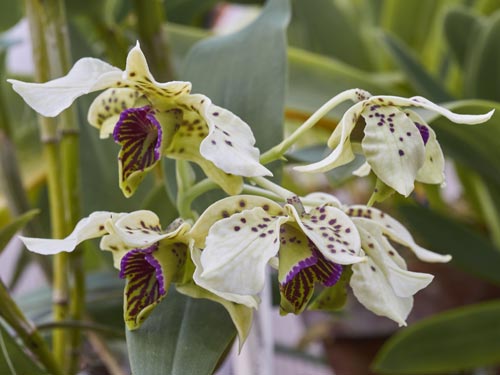 The small size of D. atroviolaceum makes it a desirable species for many tanks; be sure to allow adequate ventilation. Photo Trixty
The small size of D. atroviolaceum makes it a desirable species for many tanks; be sure to allow adequate ventilation. Photo Trixty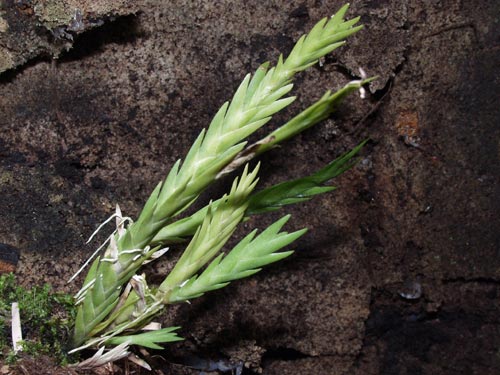 The overlapping leaves of Lockhartia oerstedii explain how it gets it's common name
The overlapping leaves of Lockhartia oerstedii explain how it gets it's common name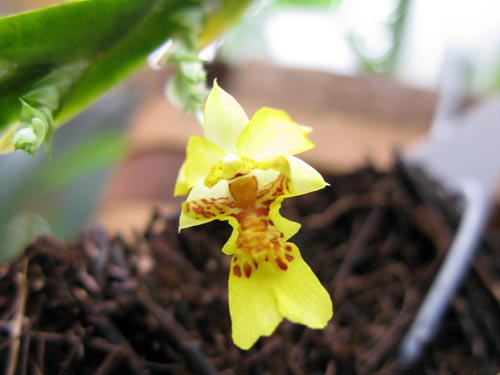 The wonderful red and yellow flower of Lockhartia oerstedii. Photo Airborne Pilot
The wonderful red and yellow flower of Lockhartia oerstedii. Photo Airborne Pilot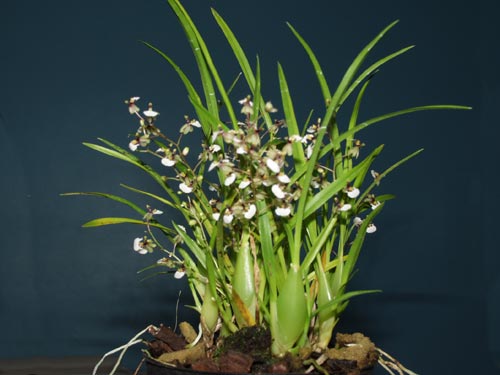 Ornithophora radicans
Ornithophora radicans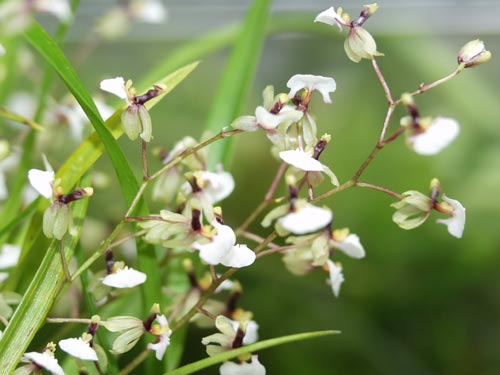 Ornithophora radicans flowers.
Ornithophora radicans flowers.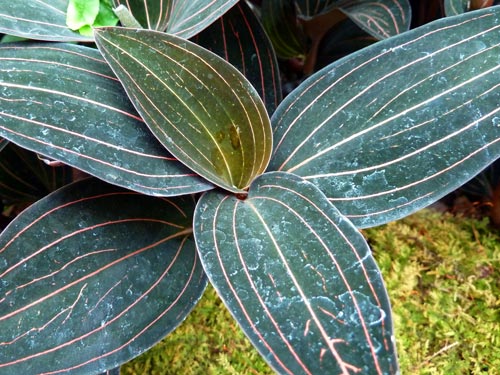 Ludisia discolor foliage. Photo Katja Schulz
Ludisia discolor foliage. Photo Katja Schulz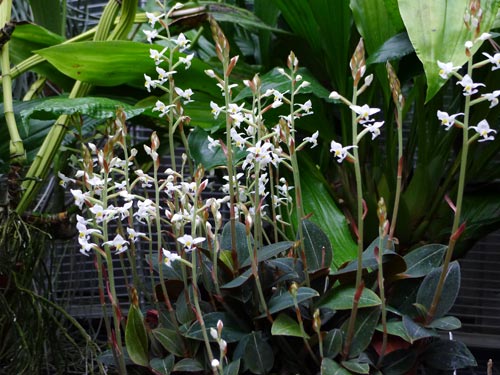 Ludisia discolor with flowers. Photo Chipmunk_1
Ludisia discolor with flowers. Photo Chipmunk_1In the moisture of the paludarium carnivorous plants can do very well. Obviously if you have terrestrial animals, no plant that can eat them should be allowed, but the many species that feed on microscopic organisms are fine. However these can be delicate plants and are perhaps more challenging than many other non-carnivorous species. Both Pinguicula and Utricularia will work in the paludarium, however many species of both genera require a dormant period of reduced watering. Unlike orchids and bromeliads grown epiphytically on a removeable bark section, these carnivorous paludarium plants will typically be planted, and therefore not moveable. Tank conditions can be adjusted, of course, if tolerable to other paludarium plant and animal species.
Pinguicula butterworts thrive in moist conditions. They catch very small insects on their sticky leaves. buy
Utricularia bladderworts. Some species are annual, some are not. Bladderworts are naturally marsh plants and will do well in the damper regions of the tank. They trap soil microorganisms underground, so are no threat to larger animal species. Utricularia have wonderful small flowers.. Look out for Utricularia sandersonii, Utricularia longifolia buy
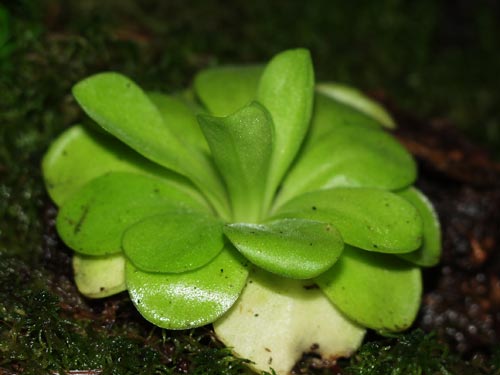 Butterwort Pinguicula have slightly sticky leaves.
Butterwort Pinguicula have slightly sticky leaves.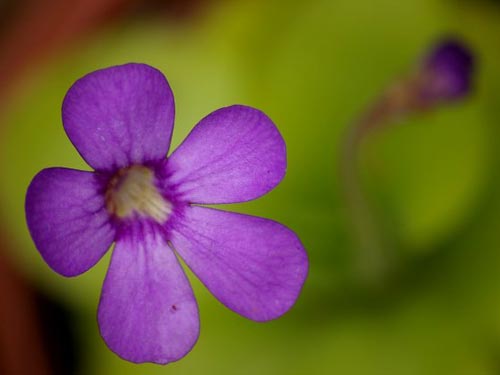 And they have the most beautiful flowers. Photo Aurore D.
And they have the most beautiful flowers. Photo Aurore D.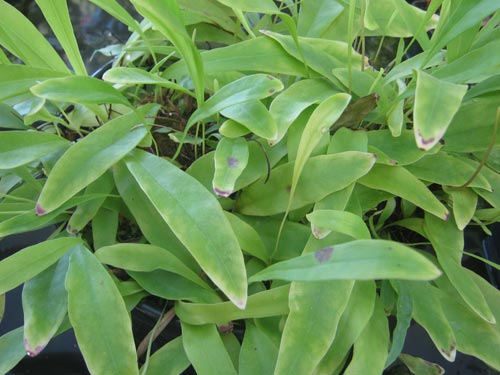 Utricularia longifolia is a tropical species from Brazil with no dormancy requirement. Photo CARNIVORASLAND
Utricularia longifolia is a tropical species from Brazil with no dormancy requirement. Photo CARNIVORASLAND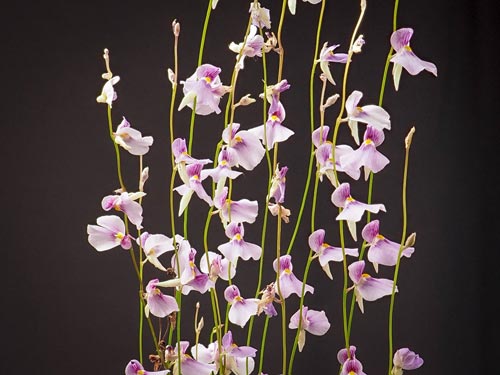 Utricularia blanchetii flowers. Photo Naoki Takebayashi.
Utricularia blanchetii flowers. Photo Naoki Takebayashi.Perhaps the biggest problem that some plants encounter in a paludarium is a suitable humidity. In the near 100% humidity of the air directly above the water section of the tank this is not a problem at all; marsh and wetland species can thrive. But so can some plants generally considered aquarium species: as long as their roots are wet, common species such as Java Fern, Brazilian Pennywort Hydrocotyle, Anubias and Cryptoryne do very well indeed growing emersed from water, even in the lower light levels of a tall tank with shade from terrestrial leaves. These plants can be used to wonderful effect to mask the border between the water and land zones of the paludarium; a stepped bank is a great way to allow planting at different depths, and grow some wonderful emersed foliage.
In the water itself floating plants such including the leaves of nymphaea water lilies, Salvinia, and the very attractive Amazon frogbit look great in a Paludarium. In truth any aquarium plant will survive in the water segment of the paludarium as long as it can tolerate the level of lighting. Anubias and Java fern do just fine in any light conditions, so in a heavily overgrown paludarium, these may be your best choice.
This wonderful 3 foot wide tank has a waterproof glass bottom, and adequate front window ventilation to keep the front glass clear. Although marketed as a Terrarium, it works as the perfect Paludarium. Front-opening doors, and removeable top for easy access and effective maintenance. Available in a wide range of sizes: with a larger surface area for ground/water dwelling species, or taller for leaf dwellers. Suitable for just about any paludarium inhabitant.
The top is equipped with closable inlets on both sides - this allows access for wires and tubing without offering an escape route for paludarium animals or the tiny invertebrates with which they are being fed. Suitable for powering Heat Wave rocks, waterfalls, filters and sensors, or injecting water through misting systems, external canister filters, etc.
All in all a great enclosure, providing a perfect environment for plants and animals, yet easy maintenance for the paludarium keeper. Available from Amazon and other good pet stores.